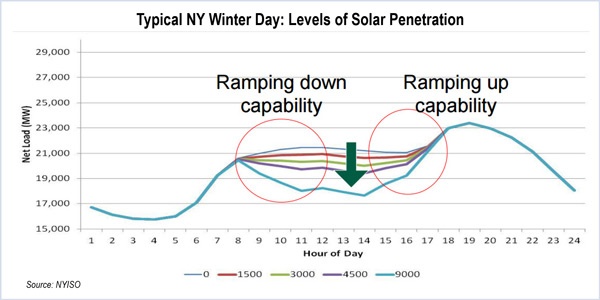By William Opalka
ALBANY, N.Y. — California’s challenge in integrating large amounts of renewable generation is illustrated by its famous “duck curve” graph. For New York, the future looks more like a platypus.
That’s how Rana Mukerji, NYISO’s senior vice president of market structures, described the impact of large amounts of solar generation on the New York grid in the winter at the ISO’s Distributed Energy Resource workshop last week.
NYISO, which released its DER Roadmap last month, held the session to open public discussion on how it will respond to the state’s Reforming the Energy Vision initiative. (See NYISO Releases Plan for Integrating DER.)
For starters, the ISO is pursuing a modest goal of planning for the next three to five years. A conceptual market structure design will be devised next year.
The roadmap, which officials described as a guide that could change as stakeholders become engaged in the process, anticipates implementation in 2021.
New York’s recently adopted Clean Energy Standard, which calls for 50% renewables by 2030, is the impetus, along with public demand for emissions-free power generation.
“We are moving very rapidly to a resource mix [that] will have intermittent resources [that] are renewable, distributed resources, and we will also have conventional generation,” Mukerji said. “I do not see conventional generation disappearing anytime soon. There is some talk of 100% renewable, but I don’t see conventional generation disappearing over the next 20 years.”
Wind generation, currently 3% of NYISO’s energy production, is projected to reach 13% by 2030.
“It took us 12 years to add 7% of renewables, but in the next 20 years we have to add 22%,” Mukerji said.
He cited projections that distributed generation without subsidies will rapidly reach grid parity. The Clean Energy Standard is going to accelerate renewable energy deployment, with solar growing from its current capacity of about 700 MW.
He added that the ISO has done simulations of up to 9,000 MW of solar in New York, which presents quite a different profile of the state’s demand in the morning and evening peaks.
“We will have needs for managing the ramping during the morning and the evening, so we might have to contemplate new products, like ramping products and load-following products in our market,” he said.
As more distributed resources are added, it will require the ability to manage bidirectional power flows.
“It will get more challenging, but in my mind it will get more interesting, and at the end of the day it gets better efficiency and it’s going to drive a cleaner, more resilient and more reliable grid,” he said.
Role of NYISO
NYISO will be charged with providing a bridge between distributed generation and the central station generators.
“We have to evolve from a corps of 400 central station generators to whatever is left of the corps of 400 with the distributed system platform, which coordinates or controls the distributed resources,” Mukerji said.
That’s where the nexus of REV and the ISO lay, with the distributed system platform, run by the utility. The ISO will not have visibility of the generation resources beyond the substation level.
“That is where the DSP will interact the with the ISO, like a super-aggregator to participate with this animated load and the sum total of the distribute resources into the markets. That is where the interaction of the DSP and the ISO is, where the coordination between the central station generation and the distributed resources happens,” he said.




